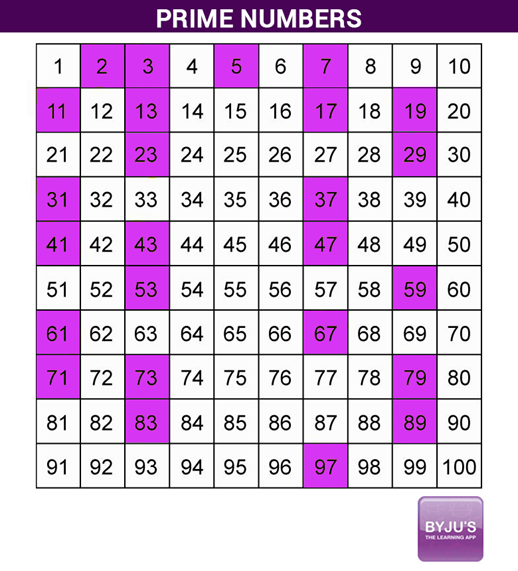Prime Numbers Up to 100
Numbers are found everywhere in Mathematics as well as in day to day life. There are different types of numbers in Mathematics. Prime numbers are one of the important ones. Let us discuss the definition of the prime number and the prime numbers up to 100 in this article.
Prime Numbers Definition
A prime number is a positive integer that is divisible by only 1 and itself. i.e. there is no number other than 1 and itself that divides a prime number.
| Also, read: |
Prime Number Properties
There are various properties that prime numbers possess. These properties are listed below:’
- Prime numbers are positive numbers greater than 1.
- For a number to be a prime number, it must be a non-zero whole number.
- Prime numbers are numbers that cannot be divided by any number except themselves and one.
- Prime numbers have only two factors.
- The two factors of prime numbers are one and the number itself.
- The way of finding the prime numbers is called integer factorization or prime factorization.
List of Prime Numbers Up to 100
The list of prime numbers 1 to 100 are given below:
| Prime Numbers from 1 to 100
2, 3, 5, 7, 11, 13, 17, 19, 23, 29, 31, 37, 41, 43, 47, 53, 59, 61, 67, 71, 73, 79, 83, 89, 97. |
Prime Numbers Facts:
- The only even prime number is 2 and the remaining even numbers can be divided by 2. So, it can’t be a prime number.
- No prime number greater than 5 ends with a 5. Since any number greater than 5 that ends with a 5 can be divided by 5, it can’t be a prime number.
- Zero and 1 are not prime numbers.
- The numbers 0 and 1, are neither a prime numbers nor a composite numbers.
How to Find Prime Numbers up to 100?
The technique to find the prime numbers up to 100 is given below:

- Write out the numbers from 1 to 100 shown above
- Keep the number 1 as it is because all primes are greater than 1
- Number 2 is a prime, so highlight the number 2, and keep the numbers as it is which are multiples of 2. (such as 4, 6, 8,10, ….)
- The number 3 is a prime, so highlight the number 3, and keep the numbers as it is which are multiples of 3. (such as 6, 9, 12,15, ….)
- The next number left is 5, so highlight the number 5 and keep the numbers as it is which are multiples of 5 (such as 10, 15, 20, 25, …..)
- At the end, the number left in the first row is number 7, now highlight the number 7 and keep all the numbers that are multiples of 7 (such as 14, 21, 28, ……)
- Finally, all the leftover highlighted numbers in the table are prime numbers.
Stay tuned with BYJU’S – The Learning App and download the app to learn all Maths-related articles with ease.